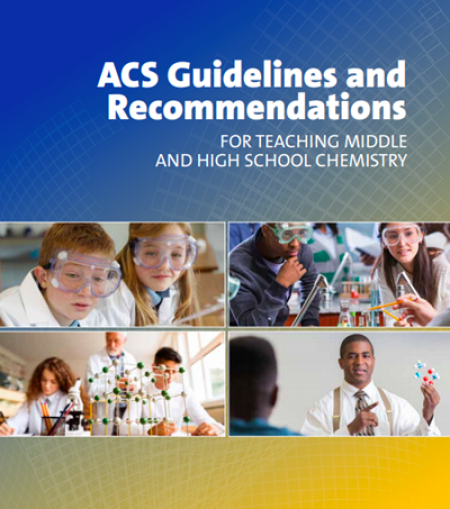About the Guidelines
Building a Chemistry Foundation for Middle and High School Students
One of the American Chemical Society’s goals is to support excellence in education by fostering the development of innovative, relevant, and effective chemistry and chemistry-related education. In the spirit of this commitment, this document is the updated and expanded version of the 2009 “ACS Guidelines and Recommendations for Teaching High School Chemistry.”
To broaden their reach and relevancy, these guidelines also consider the needs of middle school instruction, where chemistry is usually connected to and taught as physical science. While many of the topics included at the middle school level are not addressed in as much detail as the high school level, building a chemistry foundation and integrating it with other branches of science serves students well as they progress to high school chemistry and other science courses.
Purpose
The purpose of this document is to provide guidance to the middle and high school physical science and chemistry education community, with focus on the nature of instruction, the core ideas to teach, the physical instructional environment, safety, sustainability, and the professional responsibilities of teachers.
What These Guidelines Are Not
While this document is not intended to be a prescribed course outline or “how to” list, it is intended to emphasize the essential components of a successful and safe learning environment for the teaching of chemistry.
Audiences
The primary audiences for this document are middle and high school physical science and chemistry teachers, curriculum developers, principals, and other school administrators who support teachers in those roles.
These guidelines should also serve as a resource for pre- and in-service teacher preparation programs. This document describes the broad requirements necessary to teach chemistry to all students, with an emphasis on student-centered learning.
Tools for Teachers and Administrators
These guidelines recognize the professional integrity of teachers who may want to share information with their school or district administrators about ways they can be supported, best practices for teaching chemistry, and the physical environment, which includes the tools of educational technology and laboratory facilities.
These guidelines are presented to support the work of classroom chemistry teachers and provide research-based information to administrators who support those teachers.
ACS Guidelines and Recommendations
for Teaching Middle and High School Chemistry
An essential resource for middle and high school physical science and chemistry teachers, curriculum developers, principals, and other school administrators who support teachers in those roles.
Learn about the nature of instruction, the core ideas to teach, the physical instructional environment, safety, sustainability, and the professional responsibilities of teachers.


